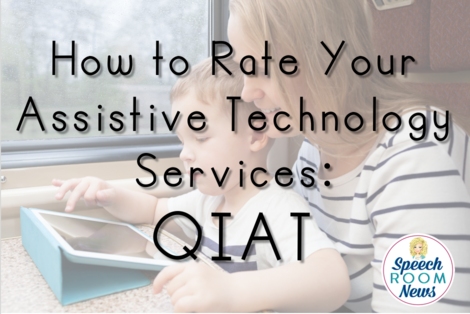As part of the coursework I’m taking for an Assistive Technology Certificate at Bowling Green, I’m taking a class about Assistive Tech Implementation. The homework for the first week of our last class was really profound for me so I thought I’d share the resource here for you.
This week our instructor asked us to rate our building/district on the Quality Indicators for Assistive Technology Services rating scale. To rate your program, start by downloading the Quality Indicators in Assistive Technology Matrices Summary Worksheets from QIAT.org. You can spend some time browsing the different areas, goals, and things to avoid while reading about the quality indicators here.
According to Carl and Bowser (2013), the QIAT indicators state that high-quality evaluation of effectiveness of AT:
- Includes clearly defined responsibilities
- Is related to one or more goals
- Includes quantitative and qualitative measurement of changes
- Takes place across environments and activities
- Requires analyzing student achievement to identify supports and barriers
- Expects that changes are made based on data
- Is an ongoing process
The QIAT indicators also emphasize the importance of clearly defined, shared responsibilities for gathering and analyzing data related to how the student is using AT to address one or more goals. Just as environments and activities are taken into account when first considering AT use, it is important to decide what qualitative, quantitative, and other measures will be used to determine effectiveness in each of the environments and activities in which AT is used. Therefore, consideration and evaluation data should be the starting point of implementation planning. (Carl & Bowser, 2103)
Using the QIAT is a great way for school teams to determine which quality indicators are an are of strength and which are an area of weakness. You could sit down with your team and complete the form together or have several team members fill them out and then compare. Develop a list of goals that would be attainable in the next year and begin to make those changes. I really like this simple AT Planner form available from the National Assistive Technology Research Institute (NATRI). Remember that Assistive Technology services are part of FAPE. The purpose of the IDEA (Individuals with Disabilities Education Act) is “To ensure that all children with disabilities have available to them a free appropriate public education that emphasizes special education and related services designed to meet their unique needs and prepare them for further education, employment, and independent living.” Assistive technology impacts education, employment and independent living, so it is the school team’s responsibility to develop an AT plan.
Have you used the QIAT? I’d love to hear about your experience! Leave me a note in the comments or email me SpeechRoomNews@gmail.com.
Carl, D. F. & Bowser, G. (2013). Assistive technology implementation: Online training module. In Ohio Center for Autism and Low Incidence (OCALI), Assistive Technology Internet Modules, www.atinternetmodules.org. Columbus, OH: OCALI.
The QIAT Community (Revised, 2012). For additional information visit the QIAT website at http://www.qiat.org. Email joy@joyzabala.com for information on QIAT research.
Join the SRN newsletter!

I'm so glad you stopped by! If you'd like to keep up with the newest posts and get exclusive free downloads, please sign up for the newsletter! Your first freebie is ready as soon as you subscribe and confirm your email!


Thanks so much for sharing! I will definitely look these over and see what needs to happen from here! You are always good about keeping us SLPs in the know! I find myself relying on you and other bloggers to keep me up to date with the new goings on because I don’t work for a school district which has a lot of funding for conferences. I do get to go occasionally, however, the money is sparse. Thanks again for sharing!! 🙂
Becki
Hi Becki! I’m so glad you found it helpful!
Thank you! This is very helpful. I often feel that teachers, administrators etc. feel that AT implementation is solely up to the SLP. It can be so overwhelming, especially in a setting such as my school where the bulk of the population is non-verbal students with autism.